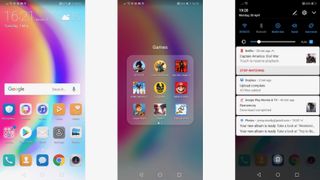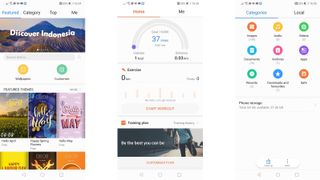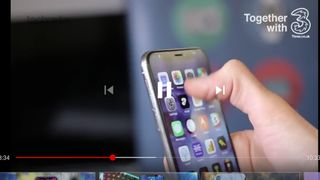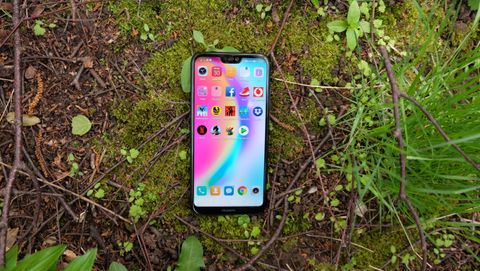Why you can trust TechRadar
- Buying Guide: 10 best cheap phones 2019
- Buying Guide: 10 best Android phones 2019
- Deals Guide: The best Huawei P20 Lite deals available right now
Interface and reliability
- EMUI 8.0 built on Android 8.0
- Not pretty but fast and functional
- Usual Huawei bloatware
The Huawei P20 Lite runs on Android 8.0, which isn’t the very latest version of Google’s OS, but it's the latest major release. Of course, the precise version of Android matters a lot less with Huawei phones, thanks to EMUI.
That’s the name Huawei gives to its own custom UI skin, which sits on top of Android like a pimped up boy racer chassis sits on top of a perfectly decent car.
To be fair, EMUI 8.0 isn’t the worst Android skin in the business. It’s reasonably fluid and stutter free, it’s easy to decipher, and its menus and pull-down notification screen don’t deviate too far from the principles laid out by Google in the first place.

The classic Android app drawer is disabled by default with EMUI, which is one of many features Huawei has borrowed from iOS. Though unlike iOS an app drawer can be enabled here.
A more handy iOS-like feature is a universal search function, accessed by dragging down from the middle of a home screen. You can search for apps, contacts, messages, calendar entries and the like in this way.

The downside of EMUI on the Huawei P20 Lite is that it remains a fairly ugly, gauche interface compared to stock Android and iOS. From the custom app icons and menus to the cheap-looking themes with which you can customise the look of your home screen, it’s all just a notch or two below classy.
Then there’s the bloatware, with home-brewed apps for Video, Music, Health, Calendar, and a dozen or so Tools - many of which act as inferior duplicates to Google’s own app provision.
Fortunately there’s always the Google Play Store, which can be turned to for superior app equivalents and indeed completely fresh launchers. Meanwhile EMUI itself is, if nothing else, reasonably customisable - so you can reinstate that app drawer if you so wish, for example.
You can also fine-tune how you like your virtual command keys to look and operate, which should make it easier to adapt if you’re coming from another Android phone brand.
Movies, music and gaming
- Most media doesn’t make use of wider screen
- Headphone jack and one underwhelming speaker
- 64GB of storage and microSD up to 256GB
With this first generation of notched smartphones, one of the first questions we ask is how well media content plays with it. Even the iPhone X continues to have issues in this department, after all.
We’ve already mentioned that Final Fantasy XV: Pocket Edition throws up some off-screen artefacts when you force it full screen. But with most other games the effect isn’t too problematic.

In most cases Huawei simply kicks in the crude-but-effective black bar effect, essentially pretending that the space either side of the notch doesn’t exist. PUBG, Bullet Hell Monday, Fancy Pants Adventure, Data Wing, Oceanhorn, NOVA Legacy, Guns of Boom, and Super Mario Run all worked in this way during our testing. No game made full use of the screen, however.
On the video front, Netflix adopts the same approach as those aforementioned games, while Youtube plays videos in their native 16:9 form factor with even thicker black borders.

Going back to Netflix support, as with all Huawei phones Netflix HD playback is not supported, which means that you don’t get full value from that crisp FHD+ screen.
This is a surprisingly common phenomenon with Android phones, and might provide sufficient incentive for mobile movie buffs to opt for a handset with a more mainstream (i.e. Qualcomm) chipset.
When it comes to audio, the Huawei P20 Lite is a mixed bag. On the negative side, you get a single speaker which is almost entirely lacking in bass. It’s clear enough, but there’s a distinctly unbalanced tinniness to the audio.
On a more positive note, there’s a 3.5mm headphone jack here, which is more than can be said for either the Huawei P20 or the Huawei P20 Pro.
More generally, you get a healthy 64GB of internal storage here, which is good for plenty of media. If that’s not enough, there’s microSD card support for up to 256GB.
Specs and benchmark performance
- Kirin 659 CPU underpowered at this price
- 4GB of RAM makes for smooth navigation
Our Huawei P20 Lite ran perfectly adequately during the test period, but we would have hoped for more from a £329 phone.
The Kirin 659 chipset that Huawei has gone with here is a distinctly mediocre chip. Indeed, it’s the same chipset that powers the Honor 9 Lite and the Honor 7X, both of which are significantly cheaper.
It’s perfectly capable of running Android 8.0 smoothly - especially combined with 4GB of RAM - and you won’t notice any significant stutters when using the fingerprint scanner or booting up the camera.
Gaming performance is distinctly underwhelming, however. Into the Dead 2 ran downright sluggishly, while rounds of Guns of Boom started out in stuttering fashion before evening out. PUBG Mobile, meanwhile, defaults to low graphical settings on the P20 Lite, which is a bit of an eyesore.

That’s simply not good enough for a phone of this price. At the risk of using Huawei’s budget sub-brand as a stick to beat it with, you can pick up the Honor 9 for less money these days, and that phone is significantly faster.
This is backed up by cold hard benchmarking facts. In our Geekbench 4 tests, the Huawei P20 Lite scored an average of 3,655 in the multi-core segment. The Honor 9 scored 6,633, while even budget champs the Moto G6 and Moto G5S Plus scored 3,807 and 4,312 respectively.

